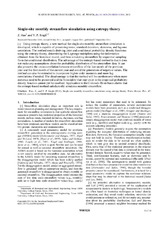| dc.creator | Hao, Z. | |
| dc.creator | Singh, Vijay P. | |
| dc.date.accessioned | 2017-09-09T08:29:46Z | |
| dc.date.available | 2017-09-09T08:29:46Z | |
| dc.date.issued | 2011 | |
| dc.identifier.citation | Hao, Z., and V. P. Singh (2011), Single-site monthly streamflow simulation using entropy theory, Water Resour. Res., 47, W09528, doi:10.1029/2010WR010208. | en |
| dc.identifier.uri | https://hdl.handle.net/1969.1/162124 | |
| dc.description.abstract | Using entropy theory, a new method for single-site monthly streamflow simulation is developed, which is capable of preserving mean, standard deviation, skewness, and lag-one correlation. The method entails deriving joint and conditional probability density functions using the entropy theory, determining the Lagrange multipliers using the information obtained from the historical record, and then simulating streamflow by sequential sampling from the conditional distribution. The advantage of the entropy-based method is that it does not make any assumptions about the probability distribution of the streamflow data. It can also preserve the cross-correlation between streamflow of the last month of the previous year and the first month of the current year and avoid the generation of negative values. The method can also be extended to incorporate higher-order moments and more lag correlations if needed. The disadvantage is that the method will be cumbersome when more statistics need to be preserved and the bimodality that may exist in the empirical probability density function cannot yet be resolved. Application to the Colorado River basin shows that the entropy-based method satisfactorily simulates monthly streamflow. | en |
| dc.publisher | American Geophysical Union | |
| dc.title | Single-site monthly streamflow simulation using entropy theory | en |
| dc.type | Article | en |
| local.department | Biological and Agricultural Engineering (College of
Agriculture and Life Sciences) | en |
| dc.identifier.doi | doi:10.1029/2010WR010208 | |


